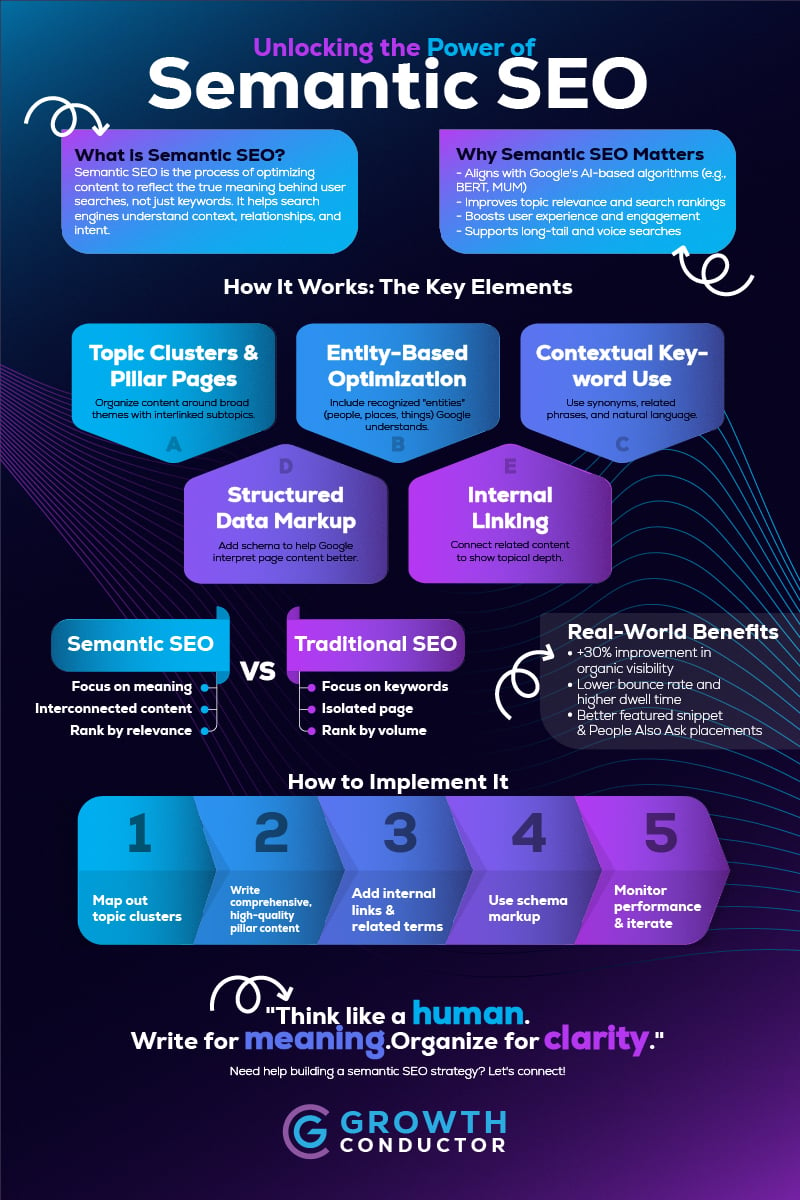A Modern Guide to Ranking in Organic Search, Voice Assistants & AI-Powered Results
Introduction
In today’s search landscape, success is no longer about keyword stuffing or gaming algorithms. It’s about meaning, intent, and relevance. This guide explores Semantic SEO — what it is, how it works, and why it’s essential for ranking in search engines and AI-driven platforms like ChatGPT, Perplexity, and voice assistants.
What is Semantic SEO?
Semantic SEO is the process of optimizing your content to reflect meaning and context, not just surface-level keywords. Instead of matching exact phrases, you align your content with how people actually think, speak, and search — and how AI interprets it.
Semantic SEO helps search engines understand:
- The relationship between topics
- The entities (people, places, things) involved
- The intent behind each query
Why Semantic SEO Matters Now More Than Ever
- Google’s BERT and MUM algorithms prioritize semantic understanding
- AI platforms (like ChatGPT and Bing Copilot) use semantic embeddings to retrieve and summarize information
- Voice search and conversational queries rely on natural language understanding
- You increase chances of earning featured snippets, People Also Ask positions, and inclusion in AI answers

Core Components of Semantic SEO
1. Topic Clusters & Pillar Pages
Group content into main themes (pillar pages) with supporting subtopics (clusters). This helps Google see topical authority.
Example: A main page on “Social Media Marketing” supported by subpages like “Instagram Growth Tactics” or “How to Use Hashtags.”
For inspiration, explore how HubSpot uses topic clusters to drive massive SEO growth.
2. Entity-Based Optimization
Use entities — real-world concepts Google recognizes via its Knowledge Graph. These include:
- People, brands, locations
- Tools and products
- Events and organizations
Tool Tip: Use Google’s NLP API to see what entities your content currently references.
You can also review this entity SEO ecommerce case study to see how structured content improved click-through and visibility.
3. Contextual Keyword Use
Move beyond exact-match phrases. Use:
- Synonyms
- Related terms
- Natural phrasing
This mirrors how real people talk and how AI understands context.
4. Structured Data Markup
Add schema.org structured data to explain your content to machines. Key types include:
Article,FAQPage,HowToBreadcrumbListfor hierarchyProductfor ecommerce
Use JSON-LD format, and validate it using Google’s Rich Results Testing Tool.
5. Internal Linking
Link related articles and service pages to build semantic relationships.
Benefits:
- Reinforces topic authority
- Improves crawlability
- Helps users explore your content more deeply
Semantic SEO vs Traditional SEO
| Traditional SEO | Semantic SEO |
|---|---|
| Focuses on keywords | Focuses on meaning and intent |
| Optimizes single pages | Builds topic clusters |
| Isolated keyword use | Uses related terms & entities |
| Rank by volume | Rank by relevance & context |
How LLMs & AI Use Semantic Signals
Large Language Models (LLMs) like ChatGPT use semantic vectors to:
- Understand the meaning of queries
- Connect content to similar topics
- Summarize or cite your website if it’s contextually strong
To increase your visibility in AI results:
- Structure your content well (use clear H2s, bullets, and FAQs)
- Embed schema data
- Use semantically rich language
- Write for clarity, not just SEO
How to Implement Semantic SEO
- Map Topic Clusters: Use tools like MarketMuse or Surfer to find related subtopics
- Optimize for Entities: Mention real-world people, companies, tools, and events in your niche
- Add Schema Markup: Especially
FAQPage,Article, andHowTo - Use Internal Linking: Show search engines how your content connects
- Update Older Content: Add new links, semantic keywords, and entity mentions
- Monitor Performance: Use Search Console + tools like InLinks or Semrush for semantic tracking
3 Real-World Use Cases
1. SaaS Company Boosts Rankings with Topic Clusters
A project management platform saw a 47% organic traffic lift by organizing content into pillar pages and topic clusters. Their visibility grew in AI-generated summaries and Google’s People Also Ask section.
See how HubSpot’s topic cluster strategy works
2. Local Business Wins with Voice Search Optimization
An HVAC company rewrote service pages using natural phrasing, FAQs, and entity optimization. They ranked in Google Assistant voice queries and saw mobile leads rise by 61%.
Explore BrightLocal’s guide to voice search for local businesses
3. Ecommerce Brand Converts More with Entities & Schema
A skincare brand implemented entity-based SEO, schema markup, and contextual product guides. They appeared in both featured snippets and AI-generated product recommendations.
Read this ecommerce entity SEO case study
Partner with Experts in Semantic SEO
Semantic SEO isn’t just a trend—it’s the blueprint for search visibility in a world shaped by AI, voice assistants, and evolving user behavior. If your current SEO strategy still revolves around keywords alone, you’re leaving opportunity on the table.
At Growth Conductor, we specialize in building scalable, AI-optimized content systems using semantic search principles. From entity mapping and structured data to topic clusters and intelligent internal linking, our team is ready to elevate your brand’s authority across organic and AI-powered platforms.
Let us turn your content into a strategic growth engine.
Ready to modernize your SEO? Complete our Project Planning tool to get started!
